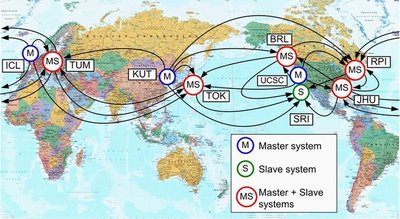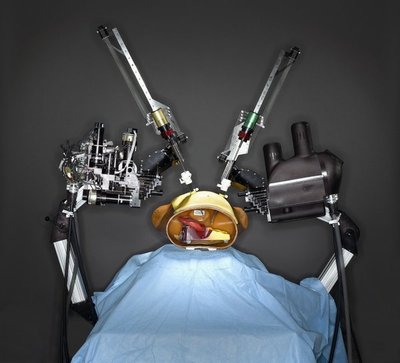September 17, 2009
Nine international teams operate biomedical robots from numerous locations
Using a new software convention called the Interoperable Telesurgical Protocol, nine research teams from universities and research institutes around the world recently collaborated on the first successful demonstration of multiple biomedical robots operated from different locations in the U.S., Europe and Asia.
Engineers from the University of Washington’s Biorobotics Laboratory helped develop the code and operated their Raven portable surgical robot during the demonstration.
In a 24-hour period, each participating group connected via the Internet and controlled robots at different locations. The tests demonstrated how a wide variety of robot and controller designs can seamlessly interoperate, allowing researchers to work together easily and more efficiently. In addition, the demonstration evaluated the feasibility of robotic manipulation from multiple sites, and was conducted to measure time and performance for evaluating laparoscopic surgical skills, a minimally invasive technique using a small incision.
The new protocol was cooperatively developed by engineers at the UW and SRI International of Menlo Park, Calif., to standardize the way remotely operated robots are managed via the Internet.
“We’re very pleased with the success of the event in which almost all of the possible connections between operator stations and remote robots were successful,” said Blake Hannaford, UW professor of electrical engineering and director of the UW’s Biorobotics Lab. “We were particularly excited that novel elements such as a simulated robot and an exoskeleton controller worked smoothly with the other remote manipulation systems.”
The protocol aims to allow engineers and designers that usually develop technologies independently to work collaboratively, determine which designs work best, encourage widespread adoption of the new communications protocol and help robotics research to evolve more rapidly. Early adoption of this protocol internationally will encourage robotic systems to be developed with interoperability in mind to avoid future incompatibilities, researchers said.
“Although many telemanipulation systems have common features, there is currently no accepted protocol for connecting these systems,” said SRI’s Tom Low. “We hope this new protocol serves as a starting point for the discussion and development of a robust and practical Internet-type standard that supports the interoperability of future robotic systems.”
Organizations that participated in the demonstration included:
- University of Washington, Biorobotics Lab – Seattle
- SRI International – Menlo Park, Calif.
- University of California, Santa Cruz, Bionics Lab – Santa Cruz, Calif.
- iMedSim, Interactive Medical Simulation Laboratory, Rensselaer Polytechnic Institute – Troy, N.Y.
- Korea University of Technology, BioRobotics Lab – Cheonan, South Chungcheong, South Korea
- Imperial College London – London
- Johns Hopkins University – Baltimore
- Technische Universitat Munchen – Munich, Germany
- Tokyo Institute of Technology – Tokyo
###
For more information contact Hannaford at blake@uw.edu or 206-543-2197. To reach SRI researchers contact Lindsay Sheppard at 650-859-2491 or lindsay.sheppard@sri.com.
More information on the Interoperable Telesurgical Protocol is at: http://brl.ee.washington.edu/Research_Active/Interoperability/index.php/Main_Page


